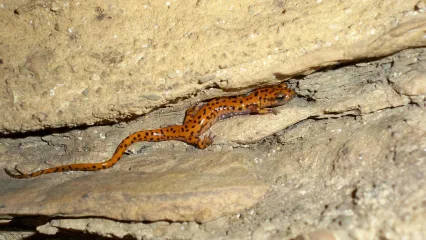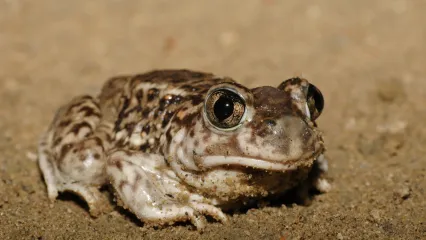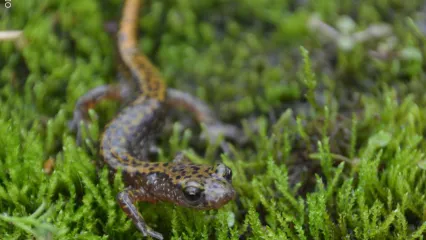
Description
The Strecker’s chorus frog is a small but robust chorus frog. Although small, it is the largest of the chorus frogs. The skin is granular, and the dorsal ground color is gray, grayish-brown, or greenish-brown with distinct elongated blotches, which may be dark brown or green. The robust arms and legs are banded with the same colors. A dark brown mask extends from the snout through the eye and onto the side of the head, where it encompasses the tympanum, to the insertion of the arm. The belly is white, becoming yellow to yellow-orange in the groin. The male’s throat becomes dark gray during the breeding season. Although these frogs are in the treefrog family, they do not have enlarged toepads.
The small tadpoles are grayish brown with fine mottling. The fins are relatively high and nearly transparent with fine reticulations. The eyes are located laterally on the sides of the head, and the throat and belly are white.
Size
Strecker’s chorus frogs are typically 1 ½ to 2 inches in body length. Females are slightly larger than males.
Habitat
Strecker’s chorus frogs occur throughout most of Oklahoma and eastern Texas, with some adjoining populations in a few counties in Kansas, Arkansas, and Louisiana. Disjunct populations occur in central Arkansas, southeastern Missouri, and western Illinois.
Life Cycle
These frogs are among the first to begin breeding in late winter. In Oklahoma, they typically begin breeding in late February, but further south, breeding may begin in November. They occur in sandy areas, including woodlands, prairies, and cultivated fields. Breeding occurs in temporary ponds, flooded fields, roadside ditches, and other small bodies of water. Breeding extends into March in Oklahoma, but later further north. During amplexus, females deposit 400 – 700 small eggs in clusters of 50 or so. These clusters are attached to small twigs or other underwater vegetation. The eggs hatch within a few days, and the tadpole stage typically lasts about two months.
During the non-breeding season, the frogs remain underground. These frogs are unusual in that they dig forward with their stout forelimbs, unlike spadefoots and toads, which dig backward with their hindlimbs.
Strecker's chorus frogs feed on small insects.
How To Observe
These small frogs are difficult to observe. They can be most easily seen in late winter by locating calling individuals at night with a flashlight or headlamp. They remain secluded in vegetation by day during the breeding season. The calls of this frog can be heard at night in late winter and early spring. The call is a single high-pitched whistle, quickly repeated.
(This profile was created by Dr. Laurie Vitt as part of a partnership between the Wildlife Department and the Sam Noble Oklahoma Museum of Natural History. It was funded as part of a larger grant to survey and inventory amphibians and reptiles of the Wildlife Management Areas of Oklahoma: T-35-P-1.)


